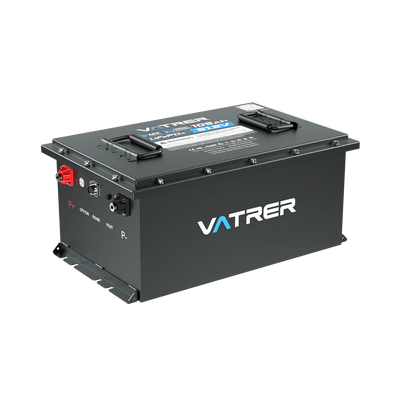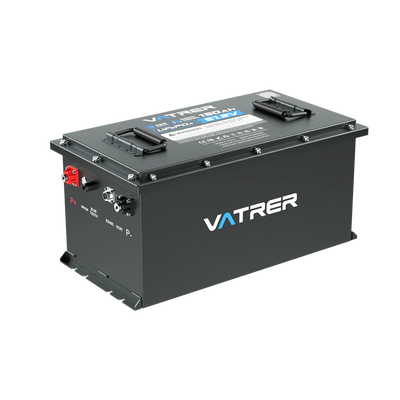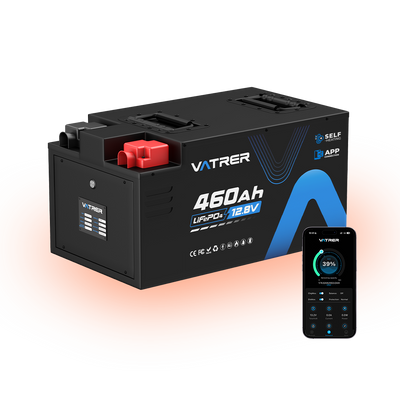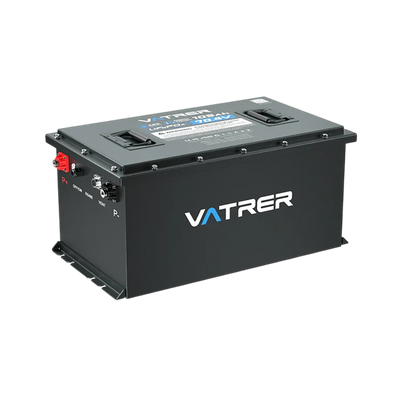
How Many Batteries Does a Golf Cart Take
A golf cart looks simple from the outside, yet everything about its performance: how far it travels, how quickly it accelerates and how much upkeep it needs, comes down to its batteries. Understanding how many batteries a golf cart takes is more than counting units under the seat. It's about knowing your system voltage, the battery types available, and how each configuration influences battery life, range, and long-term cost.
This guide walks you through the essentials, enabling you to confidently identify, maintain, or upgrade your golf cart battery setup.

Battery Basics for Golf Carts: Voltage, Setup & Types
The number of batteries in a golf cart depends on three fundamentals:
- the system voltage (36V, 48V, 72V).
- how batteries are connected.
- and the battery types used.
System Voltage
Your system voltage determines the required number of batteries.
A 36V cart needs batteries totaling 36V.
A 48V cart needs battery combinations that add up to 48V.
A 72V cart demands 72V in total.
Battery Types
Golf carts typically use two main categories of batteries:
- Lead acid batteries (flooded or AGM): Affordable, proven, but heavier with shorter lifespan and higher maintenance.
- Lithium batteries: Lighter, maintenance-free in practical use, longer lifespan, and more stable power output.
The right choice depends on the voltage your electric golf cart uses and how you plan to use it.
Here's a table to summarise the most common configurations for electric golf carts, depending on system voltage and battery size.
(Note: “batteries for your golf” often depends on the voltage and type. Always check your cart’s manual or battery tray.)
| System Voltage | Battery Count | Common Configuration | Notes |
|---|---|---|---|
| 36V | 6 batteries | Six 6V batteries | Used in older or light-duty carts. |
| 48V | 4–8 batteries | Four 12V, six 8V, or eight 6V batteries | Most common modern setup. |
| 72V | 6 batteries | Six 12V batteries | High-performance carts. |
| Lithium (48V/72V) | 1 battery pack | Single lithium golf cart battery | Simplifies wiring and maintenance. |
Key takeaways: The number of batteries is not arbitrary, it’s tied directly to the voltage system. A 48V cart might use different battery counts depending on how the manufacturer configured it (4 × 12V or 6 × 8V).
Upgrading to a single lithium golf cart battery pack is increasingly common and reduces complexity.
Why Do Golf Carts Use Multiple Batteries?
Why not just one big battery? Here are the core reasons:
- Electric motors in a golf cart need relatively high voltage and current. Connecting multiple smaller batteries in series achieves the needed voltage without designing one huge battery cell.
- It keeps costs and weight manageable and allows replacement of individual units (in lead acid systems) instead of the entire bank.
- Multiple batteries also allow more flexible weight distribution under the cart floor, improving balance and handling.
- With lithium battery technology improving, a single large pack becomes feasible, but many carts still use the multi-battery configuration out of tradition and cost.
Tip: If someone tells you “just replace one battery” in a multi-battery series, be cautious, one weak battery drags down the whole series and reduces system performance.
How to Identify Your Golf Cart Battery Setup
Here's how you can check how many batteries your golf cart uses and what voltage system it is:
- Look under the seat or the battery tray, and count the individual battery units.
- On one battery, locate the label showing voltage (6V, 8V or 12V).
- Multiply that voltage by the number of batteries you counted, gives an approximate system voltage.
Example: 6 x 6V batteries = 36V system.
Example: 4 x 12V batteries = 48V system.
- Confirm with your owner's manual or manufacturer's data plate.
- If you see one large lithium pack (often labelled “48V” or “72V” with high Ah rating) this may be a lithium upgrade rather than the original multi-battery lead acid setup.
By doing this simple check, you’ll know your “battery setup” and can better talk to suppliers, do maintenance, or consider upgrades.
How Golf Cart Battery Count & Voltage Affect Performance
The number of batteries and the system voltage are more than a technicality, they directly influence how your cart performs:
- More voltage (or better battery chemistry) means more speed and better hill-climbing ability. A 72V system will typically accelerate faster and handle slopes more easily than a 36V system.
- Range/battery capacity: Higher voltage systems often allow higher battery capacity or greater efficiency, so you can go farther on one charge.
- Efficiency & weight: More batteries generally mean more weight, which can reduce efficiency unless the system is optimised.
- Cost trade-off: More batteries or higher voltage systems cost more to buy and maintain, but may deliver lower cost per mile if you use the cart frequently.
In short, when you see “number of batteries” you should think: voltage + capacity + performance, not just count.
Maintenance Considerations: Fewer Batteries, Fewer Headaches
How many batteries you have impacts your maintenance burden, especially when comparing traditional and modern setups.
- Lead acid batteries (flooded or AGM) with multiple units: Require regular watering (if flooded), terminal cleaning, and monitoring of charge/discharge behaviour. If one battery in the series fails, the whole system suffers. More batteries are more points of failure.
- Lithium batteries: Often maintenance-free in practical terms, no watering, little terminal corrosion, longer life. A single large lithium pack replaces multiple units, dramatically reducing routine maintenance. Such as the Vatrer 48V 105 Ah golf cart battery offers real-time monitoring, built-in BMS, up to 4000+ cycles, and a much simpler maintenance routine.
Tips: If you dislike frequent checks or live somewhere difficult for battery servicing, lean toward a lithium setup for less hassle over time.
Battery Lifespan, Replacement Costs & Long-Term Ownership
Your battery setup impacts long-term costs.
- Lead acid lifespan: typically shorter lifespan, around 4-6 years
- Lithium lifespan: often a longer lifespan of 8-10 years or more
- Replacement cost: Six batteries cost more to replace than four
- Lithium upgrades: Higher upfront cost but lower long-term cost due to reduced maintenance
A well-built lithium golf cart battery, such as those from Vatrer, offers a practical way to reduce maintenance and extend battery life through high-cycle LiFePO4 chemistry, built-in BMS protection, and stable output.
Signs It's Time to Replace Your Cart Battery
Regardless of type, all batteries eventually wear out. Watch for:
- Reduced driving range
- Slow acceleration or weak hill climbing
- Longer charging time
- Charge is draining faster than usual
- Swollen or leaking battery cases
- Excessive corrosion
Tip: If one lead-acid battery fails, replace all batteries in the series to avoid system imbalance.
How to Choose the Right Battery Setup for Your Needs
Selecting the correct setup depends on how you use your electric golf cart:
- Light or occasional use / flat terrain: 36V systems with six 6V batteries are usually enough.
- Daily use or mixed terrain: 48V systems offer better range, speed, and efficiency.
- Steep terrain, heavy loads, or high-performance driving: 72V systems or a high-capacity lithium battery are ideal.
- Lowest maintenance & best long-term value: A single Vatrer lithium golf cart battery provides long cycle life, lighter weight, and maintenance-free convenience. Lithium batteries also deliver higher usable battery capacity, improving range without increasing weight.
Conclusion
So, how many batteries does a golf cart take? In most cases, you'll see 4-6 batteries in a standard lead acid setup (depending on voltage). But the real question is: what system voltage do you need, and can a modern lithium battery pack replace multiple units? The number of batteries you choose influences speed, range, maintenance and cost.
By understanding your cart's battery setup, checking the battery count and voltage, and selecting the right chemistry (lead acid or lithium), you'll set yourself up for reliable, efficient use.
When you're ready to upgrade, consider selecting a trusted lithium golf cart battery option, like those from Vatrer, that bring longer lifespan, maintenance-free operation, and more consistent performance. Make your choice based on real-world use, not just the number of batteries.
FAQs
Can I Mix Different Battery Types Or Brands In My Golf Cart?
Mixing battery types or brands in the same pack is almost always a bad idea. Even if the voltage is the same, different batteries have different internal resistance, capacity, and age-related behavior. When you combine them in one series string, the weakest unit limits performance and can be over-charged or over-discharged compared to the others.
This is true whether you're using lead-acid batteries or lithium batteries. For best battery life and stable performance, always run a matched set: same type, same brand, same age, and ideally purchased at the same time.
Should I Upgrade From 36V To 48V For My Electric Golf Cart?
Upgrading from 36V to 48V can give you better acceleration, stronger hill-climbing, and often improved efficiency, but it isn't just a matter of swapping batteries. You need to confirm that your motor, controller, solenoid, and charger are compatible with 48V.
In many cases, people choose to upgrade the entire system at the same time or use a purpose-built 48V lithium golf cart battery kit that includes battery, charger, and sometimes wiring guidance. If your cart is used mainly on flat ground at low speeds, a well-maintained 36V setup can still be sufficient, if you're regularly hauling loads or driving on hills, 48V (or higher) makes more sense.
How Do I Choose The Right Battery Capacity (Ah) For My Golf Cart?
Battery capacity, usually expressed in amp-hours (Ah), tells you how much energy your cart battery can store. Higher Ah means more range, but also more cost and (for lead acid) more weight.
Start by estimating how many miles or hours of use you want between charges, then check how much current your cart typically draws. For example, if you regularly do long rounds or use your cart for neighbourhood commuting, it can be worth investing in a higher-capacity lithium battery to avoid mid-day charging. With lithium, you also get more usable battery capacity from the same Ah rating, because the voltage stays higher for more of the discharge curve compared with lead acid batteries.
Do I Need A New Charger If I Switch To A Lithium Golf Cart Battery?
Yes. A charger designed for lead acid batteries follows a different voltage profile and may not fully charge, or could even damage, a lithium battery. Lithium batteries require a charger matched to their chemistry and recommended charge voltage. Many modern lithium packs, including those from Vatrer, are sold with or compatible with dedicated lithium chargers that work with the built-in BMS (Battery Management System). Using the correct charger protects your investment and helps the lithium battery achieve its expected longer lifespan.
How Should I Store My Golf Cart Batteries During The Off-Season?
For lead-acid batteries, the key is to store them fully charged in a cool, dry place and either keep them on a maintenance charger or top them up every few weeks to prevent sulfation.
Never leave a lead-acid pack sitting in a discharged state for months. Lithium batteries are more forgiving, but still benefit from thoughtful storage: they're best stored at partial charge (around 40-60%) and disconnected from unnecessary loads. If you're using a single lithium golf cart battery, follow the manufacturer's storage guidelines. Brands like Vatrer provide clear instructions to minimise capacity loss while the cart is parked for long periods.
Is A Single Lithium Battery Pack Safe For My Golf Cart?
A single lithium pack that's purpose-built for golf carts is generally very safe, provided it includes a robust BMS and you install it according to the manufacturer's instructions. The BMS continuously monitors voltage, current, and temperature, and protects against over-charge, over-discharge, and short circuits.
Compared to multiple flooded lead-acid batteries, a sealed lithium battery reduces risks like acid spills and hydrogen gas release during charging. Choosing a reputable brand that publishes clear specs and safety certifications, such as Vatrer, adds an extra layer of assurance that the pack is designed specifically for traction use in an electric golf cart.
What Are The Main Benefits Of Choosing A Vatrer Lithium Golf Cart Battery?
A Vatrer lithium golf cart battery is designed to replace a multi-battery lead acid pack with a single, integrated solution that offers long cycle life, stable power and much lower day-to-day maintenance.
Compared with a traditional cart battery bank, you get a lighter system, faster charging, and more consistent performance throughout the discharge, which means less “slow and weak” feeling at the end of a round. The built-in BMS manages protection and real-time monitoring, and the longer lifespan helps offset the higher initial cost.
For users planning to keep their electric golf cart for several years and wanting fewer battery-related headaches, this type of lithium setup provides a clear upgrade path.
Share






























































































